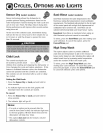
TROU
Glasses are cloudy/
spotted
Food soil remains
on dishes
Items washed in the
dishwasher or the
dishwasher tub itself
are s_ined/discolored
Items not properly
dried/moisture is
present on the
dishwasher interior
after the dry cycle
Dishware is chipped
Sanitized light does
not illuminate at the
end of the cycle
(select models)
Dishwasher drawer
will not dose
20
• Select High Temp Wash option.
• Check water temperature. Incoming water should be 120° F (49° C).
• A/ways use rinse aid. 07erify rinse aid dispenser setting, pg. 10).
• Confirm that the cloudiness is removable by soaking the item in white vinegar for
approximately 5 minutes. If removed, the problem is due to hard water. Adjust detergent
amount being used to match water hardness (pg. 9). Be sure detergent is fresh, stored
properly and is a high quality brand.
• If cloudiness is not removable, it is etching. This is an erosion of the surface of the glassware
and can be caused by water that is too hot, from using too much detergent or by
prewashing. Detergent needs food soil to act upon. If etching has occurred, the glassware is
permanently damaged. To prevent further etching, adjust the detergent amount to match
the water hardness, stop prewashing and use water heating options only when incoming
water temperature is below 120° F (49° C).
• Check water temperature. Incoming water should be 120° F (49° C).
° Run hot water at the sink before starting the dishwasher.
° Check water hardness and adjust detergent amount accordingly (pg. 9).
• Use fresh powdered detergent stored in a cool, dry place.
• Select proper cycle for the soil level (pg. 11).
• Select Smart Sense z"(select models) or proper cycle for soil level, proper option,
Sani-Rinse (select models) or High Temp Wash.
• Load items so they do not block the wash arm (pgs. 7-8).
• Load the utensil basket with knife handles up and spoon and fork handles down.
• De net place glasses over tines.
• Before loading, scrape off burnt on foods and wipe the starchy film from utensils used with
pasta, rice and oatmeal. These soils require more energy than the rest of the load to clean.
• Aluminum utensils or pans can leave marks when they rub against other items. Leave a
slight space between items.
• Iron deposits in the water can leave a yellow, brown or orange film on dishes or the
dishwasher tub. A rust filter may be needed. Check with a water treatment company.
• Separate silver or silver-plated silverware from stainless steel. These metals can be damaged
by contact with each other during washing.
• Color from tomato sauces may adhere to the interior parts of the dishwasher (pg. 16). If light
staining has occurred, leave the drawer open to oxidize the stain away. Use a dishwasher
detergent that contains chlorine to better fight staining.
• Certain dishwasher detergents may stain silver. Tryanother brand of detergent.
• Be sure Sensor Dry (select models) is selected.
• Water droplets may form on the inner tub as part of the drying process. This is normal.
• Be sure the Rinse Aid dispenser is filled.
• Use a rinse aid separate from the detergent regularly to improve drying performance. Adjust
Rinse Aid setting to High (see pg. 10) when rinse aid is present in the dispenser.
• Check water temperature. Incoming water should be 120° F (49° C).
• Select Hi Temp Wash option.
• Increase detergent amount to match water hardness (pg. 9).
° Load properly. (pgs. 7-8)
• Plastic and items with non-stick surfaces are difficult to dry because they have a porous
surface which tends to collect water droplets. Towel drying may be necessary.
• Glasses and cups with concave bottoms hold water and require towel drying. Locate these
items on the more slanted side of the rack for improved results.
• Load dishes according to instructions so they do not strike each other (pgs. 7-8).
• Washing fine antique china/crystal in the dishwasher is not recommended.
• De not load glasses over the tines.
° De net overload.
° Make sure variable tines (select models) are properly adjusted and in place before loading.
° Sani-Rinse (select models) was not selected.
° Sanitization can only be achieved with the Smart SenseT"(select models),
Anti-Bacterial (select models) or Normal Wash cycles.
Sanitization may not be achieved if there is an interruption of the cycle, power failure or if
incoming water temperature is below 120° F (49° C).
Be sure items do not extend above the inside top edge of the drawer.


















